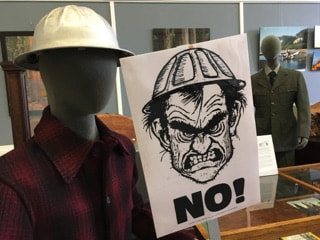Old Growth Redwood Chainsaw
Courtesy of Timber Heritage Association
| | This incredible chainsaw, with a 6 foot bar, was used to cut old growth redwoods in the forests of Humboldt County. It is on loan to the museum during our exhibit from Timber Heritage Association, an organization that is building a world-class collection of logging tools, machinery, and more in Samoa. They're locally known for their Speeder Car rides that run all around the county in the summertime. |
NO! Angry Logger Poster
Courtesy of Redwood National and State Parks
| When I first started scouting items to borrow for the exhibit, this poster appeared in the Redwood National and State Parks Archives. With it's scowling face and furrowed eyebrows with bold text, I thought it would make a great presentation piece in the exhibit. This photo is a reprint of the original. The Parks Archives loaned us many of the high-impact pieces on display, including the standing map displaying the expansion of the Park, the Clean Logged and Seeded sign in the pro-logging propaganda case, the vibrant photos taken by Don Anthrop throughout the exhibit, and the burls on display in the center of the exhibit. |
Lucille Vinyard Case
Courtesy of Humboldt State University Special Collections Interns
| | This case contains a number of personal items from Lucille Vinyard, whom many call the mother of Redwood National Park. Items related to her work to establish the parks can be found at Humboldt State University or online here. This case offered interns at Humboldt State the opportunity to apply skills from their ongoing internship, sponsored by the National Parks Service, in bringing archives into the public eye. |
KEK Stereoscope
Donated by Natural Resource Management Corp
| This tool was used to map out the expansion of the Redwood National Park in the 1970s and 1980s. it uses aerial photos, mirrors, and magnifying glasses connected to a movable frame to allow the user to trace out the terrain onto a separate map. These types of tools were used to create what later became base maps for GIS and GPS, and for programs like Google Maps. | |


 RSS Feed
RSS Feed